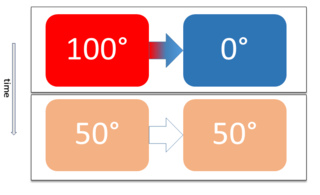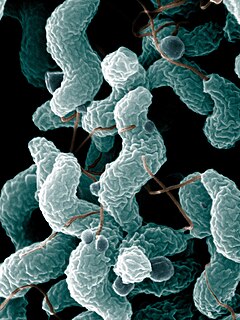Related Research Articles

The Ćuk converter is a type of buck-boost converter with zero ripple current. Ćuk converter can be seen as a combination of boost converter and buck converter, having one switching device and a mutual capacitor, to couple the energy.

Two physical systems are in thermal equilibrium if there is no net flow of thermal energy between them when they are connected by a path permeable to heat. Thermal equilibrium obeys the zeroth law of thermodynamics. A system is said to be in thermal equilibrium with itself if the temperature within the system is spatially uniform and temporally constant.
Hijiki, sometimes called hiziki, is a brown sea vegetable growing wild on rocky coastlines of East Asia.
In model theory and related areas of mathematics, a type is an object that describes how a element or finite collection of elements in a mathematical structure might behave. More precisely, it is a set of first-order formulas in a language L with free variables x1, x2,…, xn that are true of a sequence of elements of an L-structure . Depending on the context, types can be complete or partial and they may use a fixed set of constants, A, from the structure . The question of which types represent actual elements of leads to the ideas of saturated models and omitting types.

Campylobacterota are a phylum of bacteria. All species of this phylum are Gram-negative.
Mycobacterium arupense is a slowly growing mycobacterium first isolated from soil and human sputum samples in Spain. Etymology: arupense, pertaining to the ARUP Institute for Clinical and Experimental Pathology, where the type strain was characterized.
Mycobacterium palustre is a slowly growing mycobacterium first isolated from an environmental source in Finland. It is potentially pathogenic, and has been isolated from human and veterinary clinical specimens.

Cronobacter is a genus of Gram-negative, facultatively anaerobic, oxidase-negative, catalase-positive, rod-shaped bacteria of the family Enterobacteriaceae. They are generally motile, reduce nitrate, use citrate, hydrolyze esculin and arginine, and are positive for L-ornithine decarboxylation. Acid is produced from D-glucose, D-sucrose, D-raffinose, D-melibiose, D-cellobiose, D-mannitol, D-mannose, L-rhamnose, L-arabinose, D-trehalose, galacturonate and D-maltose. Cronobacter spp. are also generally positive for acetoin production and negative for the methyl red test, indicating 2,3-butanediol rather than mixed acid fermentation. The type species of the genus Cronobacter is Cronobacter sakazakii comb. nov.

Catapodium is a genus of Eurasian and North African plants in the grass family.

Favosites is an extinct genus of tabulate coral characterized by polygonal closely packed corallites. The walls between corallites are pierced by pores known as mural pores which allowed transfer of nutrients between polyps. Favosites, like many corals, thrived in warm sunlit seas, feeding by filtering microscopic plankton with their stinging tentacles and often forming part of reef complexes. The genus had a worldwide distribution from the Late Ordovician to Late Permian.
Canarium fusiforme is a species of sea snail, a marine gastropod mollusk in the family Strombidae, the true conchs.
Lake Ejagham is a small lake near Eyumodjock in the Southwest Region of Cameroon. Unlike many other lakes in the region, it is not a volcanic lake, but is likely a solution basin formed by groundwater during the last Ice Age. This highly isolated lake is roughly oval in shape, lacks an inflow, but has an outflow into the Munaya River. The outflow is impassable to most fishes because of a waterfall.
Coptodon fusiforme is a species of fish in the cichlid family, endemic to Lake Ejagham in western Cameroon. It was only scientifically described in 2010, so has not been rated by the IUCN, but it likely faces the same risks as the critically endangered C. deckerti, which is threatened by pollution and sedimentation from human activities, a catfish from the genus Parauchenoglanis that has been introduced to the lake, and potentially also by large emissions of carbon dioxide (CO2) from the lake's bottom (compare Lake Nyos), although Ejagham is too shallow to contain very high amounts of this gas.

The swamp darter is a species of freshwater ray-finned fish, a darter from the subfamily Etheostomatinae, part of the family Percidae, which also contains the perches, ruffes and pikeperches. It is endemic to the Eastern United States.

Fucosterol is a sterol isolated from algae such as Ecklonia cava or Ecklonia stolonifera.
Filomicrobium is a genus of bacteria from the family of Hyphomicrobiaceae which was first described in 1987 by Schlesner
Filomicrobium insigne is a Gram-negative, aerobic, motile bacteria from the genus of Filomicrobium which was isolated from soil in the coastal Shengli Oilfield in Shandong Province in eastern China.
Matsubaraea is a monotypic genus of percomorph fish from the subfamily Hemerocoetinae. The only species in the genus, Matsubaraea fusiforme is found in the western Pacific in the waters around Japan, Thailand and the Philippines on sandy substrates. It feeds on mysids. The generic name honours the Japanese ichthyologist Shinnosuke Matsubara who was director of Imperial Fisheries in Tokyo.
Onychostoma fusiforme is a species of cyprinid in the genus Onychostoma. It inhabits inland wetlands in Asia and has a maximum length of 23.0 centimetres (9.1 in). It is used for food locally.
Oxydema fusiforme, commonly known as citrus flower beetle, is a species of weevil widely distributed in Indo-Pacific islands such as Sri Lanka, the Seychelles, Rodriguez Island, the Marquesas Islands, the Samoan Islands, the Hawaiian Islands, Guam Island, and Marcus Island.
References
- ↑ LSPN lpsn.dsmz.de
- ↑ Straininfo of Filomicrobium fusiforme
- 1 2 UniProt
- ↑ Wu, X. -L.; Yu, S. -L.; Gu, J.; Zhao, G. -F.; Chi, C. -Q. (2009). "Filomicrobium insigne sp. nov., isolated from an oil-polluted saline soil". International Journal of Systematic and Evolutionary Microbiology. 59 (2): 300–5. doi: 10.1099/ijs.0.65758-0 . PMID 19196769.
- ↑ Deutsche Sammlung von Mikroorganismen und Zellkulturen